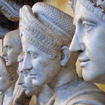Teaching Practice 8
Beginner level
Description
Materials
Main Aims
-
To provide clarification and practice of be in the past simple tense in the context of memories & past events.
Subsidiary Aims
-
To provide accuracy and fluency speaking practice in a conversation in the context of memories & past events.
Procedure (42-57 minutes)
Teacher will come forward with a camera (realia), stick a picture of himself on the WB which was taken two years ago. Then I am going to say "Ask me questions", pointing at the picture and myself. The purpose of this lead-in is to get students to ask me simple questions like "What? Where? When?", I shall put the relevant answers on the board and emphasize especially the answer to "When?". Elicit that this is in the past (good memories), and all along I shall used "was" and "were" when answering.
Teacher will show the new task to come, which is a text they're gonna have to read individually. T will split class in two, students As and Bs, so half will be given a text about a man telling his memories about the 1998 World Cup finals, and the other half will be given a text about a woman telling her memories about a new year's eve in Sydney. After reading alone, they will be in pairs and I will give them a sheet with four questions on it "Who? What? When? Where?", so each and everyone of them are gonna ask these questions to each other and answer with that they think is correct. T will draw a table on the WB with these questions for the two protagonists, and elicit the answers from the pairs. Then T will ask "what's important here?", and the students shall answer "when?". T will ask "Why?", in order to elicit again that 'be' is not in its present simple form, but in another form. ICQs: - Do you read with your partner? No. Alone. - Do you ask questions to your partner after reading? Yes. - How many questions? 4.
Teachers will write four excerpts from the texts on the WB to focus on the language. e.g. - I was at the World Cup Final. - We were near the Opera House. - The stadium wasn't full. - They weren't very happy. I am gonna use colors to highlight the verbs in these sentences and so some students could guess that all of these are in the past, the verb here is 'be' and we've got positive & negative. CCQs: Is this sentence in the present or in the past? Is this sentence positive?
Teacher will keep the model sentences on the board and will draw a table: TO BE (Past Simple) POSITIVE (+) NEGATIVE (-) I You He / She / It We You They Then I am gonna ask for volunteers (or victims) to help me fill in the table so I could get a clarification with every personal pronouns. When done, I'm gonna draw a timeline, to get things clear so there are no more mistakes, on one end we'll have Past and on the other end Present, T will show with the use of symbols that "I am" is still valid now, while "I was" is not.
Teaching will show the first activity students will have to do, it's about choosing the correct form of 'be' in these sentences. Ss will just have to circle the right answer. I'm gonna give the answer key and then drill together.
For this activity, Teacher will do a demo with a student, they will be working in pairs, each student has a paper with four positive statements on it, but all of these are false, so they need to ask their partner to do a negative statement, and if they can, give the correct answer. T will change pairs in this activity. ICQs: Do you do the negative sentences by yourself? No, with my partner. Do you have the same sentences as your partner? No. They are different.
Teacher will try to draw a boy on the WB, and will write me below it, eliciting that we are going to talk about us in the past. Teacher will have to demo this one, sitting in a group of three, students will need to speak about their memories of when they were ten years old. T is going to do it first to show the way, e.g.: When I was ten, I was happy. I wasn't good at school. My favourite cartoon was Batman. My favourite city was Paris. My favourite food was pizzas. I was always late for class. etc. And if someone in the group shares the same idea, he can say "Oh really! Me too!", or it's the opposite "Hmmmm...no. I was different.". Feedback is gonna be like "tell me about this student in your group when he was ten." ICQs: Do you talk with your group? Yes. How many sentences? You decide.
Teacher will write on the WB any errors that has been done, it will serve as a feedback for the whole lesson.

